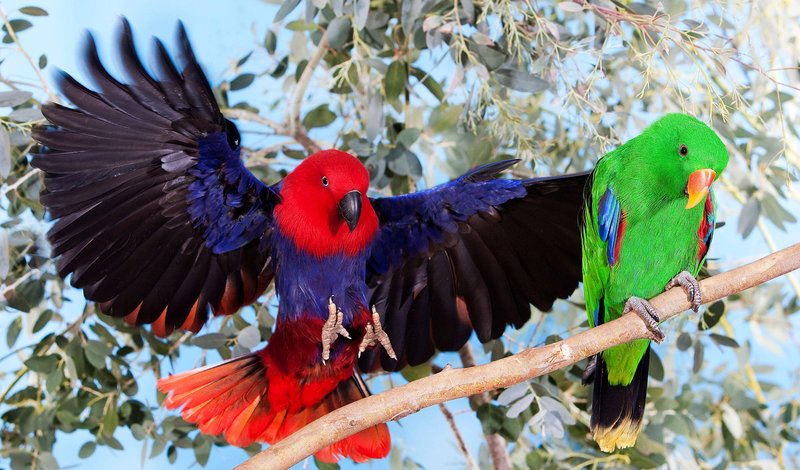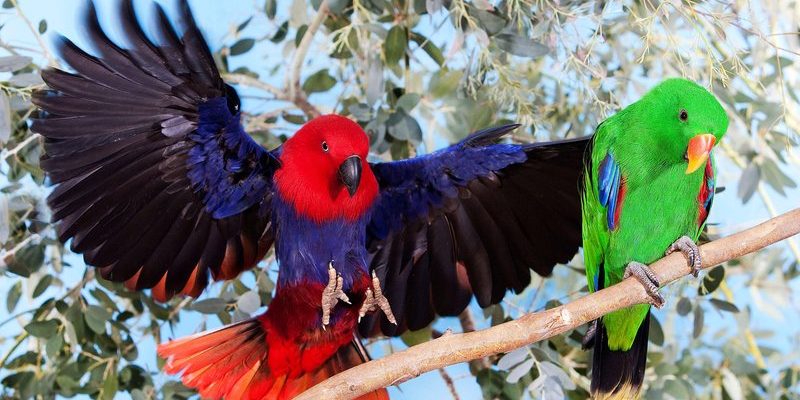
You might picture these parrots perched high in the trees of the Solomon Islands or New Guinea, where they call home. The way they adapt to their environment is nothing short of amazing, serving as a reminder of nature’s ingenuity. So, let’s dive into the unique attributes that help Eclectus parrots not just survive but thrive in their lush habitats.
Physical Adaptations: Nature’s Masterpieces
One of the first things you’ll notice about Eclectus parrots is their striking appearance. Males are a vibrant green, while females sport a stunning red and purple combination. This sexual dimorphism isn’t just for show—it serves a purpose. The male’s green feathers help him blend in with the foliage, making it harder for predators to spot him. Meanwhile, the female’s brighter colors attract mates and signal her presence.
Their beaks are another fascinating adaptation. The Eclectus parrot has a strong, curved beak that helps them crack open tough seeds and nuts. This is crucial because their diet mainly consists of fruits, seeds, and nuts found in their tropical environment. The beak’s design allows them to access food that many other birds might struggle with. Plus, their sharp tongues help them manipulate food items, ensuring they get every last morsel.
But there’s more! Their feet are zygodactyl, meaning they have two toes facing forward and two backward. This unique foot structure gives them a strong grip on branches and helps them navigate their arboreal habitat with ease. It’s like having built-in climbing gear! This adaptation is essential for foraging and nesting in the treetops, where they spend most of their lives.
Behavioral Adaptations: Intelligence and Social Skills
Eclectus parrots are highly intelligent and social creatures. Their ability to adapt behaviorally is just as critical as their physical traits. For instance, they have complex social structures and often live in small flocks. This social behavior provides safety in numbers, making it easier for them to find food and evade predators.
You might be wondering how they communicate within their flocks. These parrots have a remarkable range of vocalizations. From soft whistles to loud squawks, they use sound not just to communicate with each other, but also to alert the group of any dangers nearby. This adaptability in communication keeps the flock informed and safe.
Here’s the thing: their intelligence also plays a big role in their adaptability. Eclectus parrots are known for problem-solving skills. They can manipulate objects, learn new tasks, and even mimic sounds. This ability allows them to adapt to new situations, whether it’s finding food in unfamiliar areas or coping with changes in their environment.
Nesting Habits: Clever Choices
When it comes to nesting, Eclectus parrots show us just how adaptable they can be. They typically choose tree hollows for their nests. This choice protects their eggs and chicks from predators and harsh weather. The hollow provides a cozy, safe space for raising their young.
Interestingly, these parrots often return to the same nesting sites year after year. This behavior indicates their ability to recognize and remember safe locations, which is vital for survival. They’ll often select a site that’s suitable for rearing chicks, ensuring a high chance of success.
But there’s a twist: if a nesting site becomes too unsafe or scarce, Eclectus parrots can adapt by finding a new hollow. This flexibility in nesting behavior is crucial, especially as deforestation and climate change alter their natural habitats.
Feeding Adaptations: A Diverse Diet
Eclectus parrots have a varied diet, which is a significant aspect of their adaptability. They primarily eat fruits, seeds, nuts, and even flowers. This diverse diet isn’t just a preference; it’s a survival strategy. By eating different types of food, they can adapt to seasonal changes and ensure they have access to nutrition year-round.
Their \emph{foraging behavior} is another adaptability trait. These parrots spend a good part of their day searching for food, often moving to different areas to find the best resources. They’re also known to use their beaks to dig into the bark of trees to find hidden insects, adding protein to their diet.
Think about this: their feeding habits also show how they interact with their environment. By eating various fruits and seeds, they contribute to the ecology of their habitat. As they consume these items, they help in seed dispersion, which plays a vital role in the growth of their forest ecosystem.
Environmental Challenges: Resilience in the Face of Change
Like many animals, Eclectus parrots face environmental challenges, from habitat loss to climate change. However, they show remarkable resilience. Their adaptability helps them cope with these changes. For instance, if their usual feeding grounds are disturbed, they can shift their foraging patterns to new locations.
In areas where deforestation has occurred, some populations have been observed adapting to urban environments. They’ve been spotted foraging in parks and gardens, showcasing their ability to utilize new resources. This kind of flexibility is crucial for their survival in a rapidly changing world.
However, with these changes come threats. As their natural habitats decrease, the importance of conservation efforts becomes more evident. Protecting their environments ensures that these extraordinary birds can continue to thrive.
In a nutshell, Eclectus parrots are truly amazing creatures. Their ability to adapt physically, behaviorally, and environmentally is a testament to the resilience of nature. They remind us that adaptation isn’t just about survival; it’s about thriving in a world that’s constantly changing.
So, the next time you see an Eclectus parrot, take a moment to appreciate all the ways it has adapted to its environment. Their colorful feathers and playful behavior are just the surface of what makes them special. By understanding their adaptations, we can better appreciate the delicate balance of nature and the importance of protecting these remarkable birds and their habitats.

